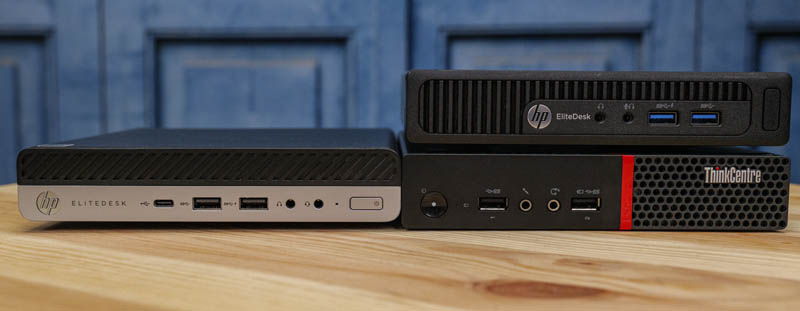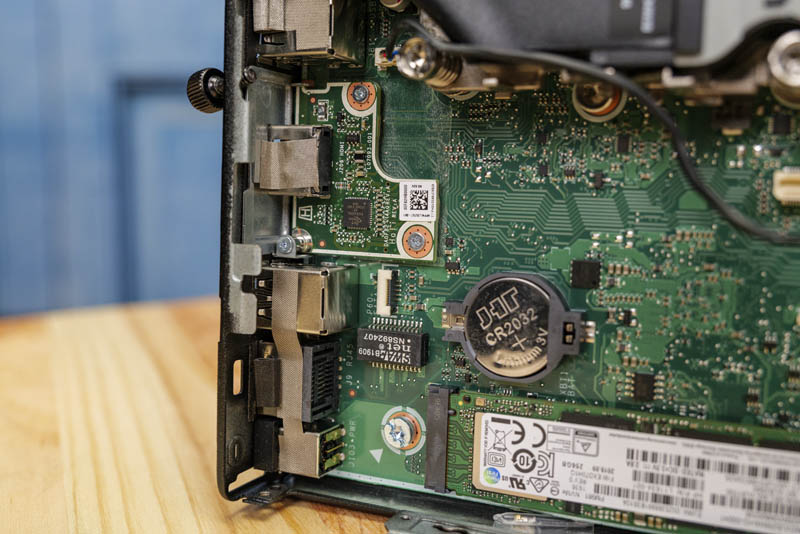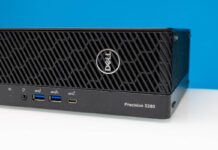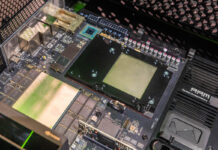Today we have another edition of our Project TinyMiniMicro series. This time, we are focusing our efforts on the AMD Ryzen-based HP EliteDesk 705 G4 Mini. Although the generational jumps in the 1L market tend to be muted, we saw a huge generational jump between G3 and G4. We also are taking the opportunity to compare this unit with our recent Lenovo ThinkCentre M715q piece since both of these units we received with the same processor.
Project TinyMiniMicro HP EliteDesk 705 G4 Mini Video
As part of this project, we are releasing videos with some additional looks at the systems and some more candid thoughts. Here is the video for this:
This article will have a bit more since there are some facts and concepts easier to convey using text rather than video. Pop this one out and watch on YouTube while you read through the review.
Project TinyMiniMicro Background
In Project TinyMiniMicro we are purchasing a large number of these devices from different sources. While a standard STH review is of a new product, these TMM nodes occasionally have specs that differ from what one would expect. In all of these pieces, we are going to talk about what makes the nodes unique. We are now well over 20 different nodes to increase diversity. We are testing these on a more circular economy/ extended lifecycle basis to see how they can be deployed after their initial use as corporate desktops.
Price-wise, we paid around $400 for our test unit (used.) This was around $120 more than the Lenovo M715q and about twice what we paid for the HP EliteDesk 705 G3 Mini. Our unit has an AMD Ryzen Pro 2200GE processor, 8GB of DDR4 memory in a single SODIMM, and a 256GB NVMe SSD. The Lenovo unit only had half the SSD capacity but came with a number of accessories that this unit did not.
We found the CPU was much faster than the previous pre-Ryzen generation. Its integrated Vega 8 GPU is more than capable of video offload features for watching STH videos on YouTube (shameless plug intended.) Having both the Lenovo and HP versions allows us to see the cross-vendor performance. We also installed our usual Proxmox VE and Ubuntu OSes on this system without issue and it works well as a server. As one would expect, VMware is more challenging due to the Realtek RTL8111 NIC.
In this era where many will have children schooling at home, there is a case to be made where this type of system can be an educational workstation for the next semester or two and then converted to a lab node if that situation changes. With WSL2 and Windows 10, it may also be possible to have this be an additional lab node while it is still being used for education, although a bad result would be rebooting a system in the middle of a school day test.
HP EliteDesk 705 G4 Mini Hardware Overview
The chassis itself is a fairly standard design for the earlier HP Mini’s. It measures 177 x 175 x 35mm which puts it just over 1L in displacement. The front of the system has a headphone/ headset jack and headphone jack for audio and two USB 3.0 Type-A ports for basic connectivity. One of those USB ports has “always on” power.

A big differentiator with this versus the HP EliteDesk 705 G3 Mini and the Lenovo M715q Tiny is that the front USB Type-C port. With so many devices using USB Type-C these days, this is a great feature.

The rear of our unit has two standard DisplayPorts. The optional port on our test unit is HDMI port, but that can also be blank or a different interface (e.g DP, VGA, or serial.) There are four USB 3.0 ports as well.

The RJ45 1GbE port is Realtek RTL8111 powered NIC. That NIC is well supported in Linux and Windows. It is not supported out of the box by solutions with weak hardware support such as VMware ESXi. There are ways to get the driver to make this work in older ESXi versions.
HPE also has a nub for an antenna on the rear. If we compare that to the Lenovo M715q (shown below) or the HP EliteDesk 705 G3 (shown below without the feature) the other AMD-based units use more standard and larger WiFi antenna setups. There was a big shift in design between the HP G3 and G4 AMD-based units.

The system cover comes off by simply unscrewing a screw. Inside we can see a familiar HP layout. The CPU is on the top. Here we can see the CPU, heatsink, and fan assembly dominate the top part of the system. The two DDR4 SODIMM slots are in-line with this complex as well, which is different than the Lenovo M715q. The CPU in our unit was an AMD Ryzen Pro 3 2200GE. This is a 35W 4 core/ 4 thread CPU with integrated Vega 8 graphics. There are other options with higher-end Ryzen 5 APUs which offer eight threads.

Under the fan, we had two SODIMM slots. Our unit came with 1x8GB DDR4 SODIMM so for around $25 we added a second one for a total of 16GB.

In our system, we did not get the 2.5″ drive assembly. Instead, we have a M.2 NVMe SSD. In our unit, we received a Samsung PM981 256GB NVMe SSD which is a higher-end unit than we see in other systems. For example, the Lenovo M715q Tiny had a WD SN520 DRAM-less SSD.

The 2.5″ drive assembly is completely absent in our unit. As a result, one would need to source the 2.5″ assembly plus the small cable that goes into the internal custom SATA header that is flanked by the rear I/O, HDMI port PCB, and battery below. This is not terribly expensive but often costs around $30 on the secondary market.

Our unit did not come with a WiFi module, but it was wired for WiFi. There is a M.2 slot where one can put an 802.11ac with Bluetooth 4.x module or a WiFi 6 module like the AX200. It is nice that the system is pre-wired even if the M.2 adapter is not present.

Overall, this is a really nice package from HP. Our unit was built in mid-November 2019 so it was still under a 1-year onsite warranty. It also included Windows 10 Pro via an embedded license. We will also notice we had the “35W” version. There is another higher-performance 65W version that uses higher-power CPUs.
We have more details on the spec page which will be next along with a look at performance.





When reflecting on the wisdom “the first lesson learned is to double-check that the units have the features that you want” what I understood is that these machines are difficult to upgrade in the field because they use custom parts. For example a used $30 hd bracket and cable send 10 times more dear than the interchangeable brackets and cables used in many desktop computers.
These tradeoffs in size, price, performance and maintainability are interesting. I wonder if it will take government regulation to ensure compatibility across brands to avoid excess landfill as required for the plugs on the chargers in the mobile phone industry. Can the power brick of the Lenovo supply this HP mini micro?
One system I suggest you check for this series is the Hardkernel ODROID-H2+. It’s a single board computer but I think it qualifies as a TinyMiniMicro. I just bought one as a desktop replacement because the 8GB Raspberry Pie required too many compromises.
Eric – the brackets do need to be somewhat customized for the chassis, so I can see why.
Jon – The ODROID-H2+ is a fairly different segment than these. It is a lower power/ performance and was not an ex-corporate desktop PC. With that said, I do love the dual 2.5GbE on those.
There’s what seems to be a small mistake – under the heading “HP EliteDesk 705 G4 Mini Hardware Overview”, the first line is “The chassis itself is a fairly standard design for the earlier Lenovo Tinys.” – surely this is meant to be “standard design for the earlier HP tinys”?
FYI: I had the Ryzen Pro 5 model. It could not handle my 4K at 60 Hz monitor. YouTube would stutter with 4K videos. Even 1080p was not smooth. Took a bit of time to convince the store to take it back.
My office has 2 of these with the Ryzen 5 2400G in them and either 16GB or 32GB RAM. THey are very nice for office desktops as you can use the VESA mount and put them behind your monitor. We have liked them so far and when it comes time for desktops to be replaced, we will probably be going with these for all our employees.
anyone who tried to fit a non PRO Ryzen on to these?
This 35w version can be upgraded with a 65w Ryzen pro 2400G or the motherboard need to be changed also? In the manual just say that the 2400G is compatible but not specify if it need a 90w o 150w power adapter or a new motherboard with a better cooling system.
Luis – Usually the 65W has at least different power supplies, fans, and cooling. So there is enough to swap that it is not usually worth the effort.
I went to update the bios HP EliteDesk 705 G4 Mini AMD Ryzen, it stuck on the screen with the message “HP SURE START RECOVERY” I can no longer update the bios or enter the bios settings, can anyone help me, thanks in advance.
The review could have mentioned the option for discrete graphics via MXM connector. I know it is not a thing for servers, but HP list that as mandatory for Ryzen CPUs here:
https://support.hp.com/us-en/document/c06101574#AbT2
Which doesn’t seems to be true as the review unit didn’t have the DGPU and just worked fine.
My own unit doesn’t work with 2200G though, but that might be because it should be 2200GE as previous CPU was A10-9700E.
I may have a dud, but mine is not booting with A10 9700e and it previously has a 2400GE.
I’m not sure on parts availability of drive sleds, or the wisdom of running a 2.5″ SATA (2 years on 1TB NVMe are now about $40)
does anyone know where to find the custom sata cable that goes into this mother board to install a 2.5 ssd?
If you plan to get these since they are really cheap and plan to use the 2.5 inch sata disk, I recommend looking at another PC. I have three of these and with M.2 they were working fine. I upgraded to a 4TB M.2 disk and 8TB sata disk. SATA fails at around 100 hours of being powered on with all 3 nodes.
I have swapped SATA cables with extras I bought, swapped disks with motherboards, upgraded BIOS, disabled BIOS power management, made sure disks firmware are updated, and it is still getting this issue. If it was only on one node I’d suspect a bad SSD or node, but it looks like to me the controller has some issues.
Can you attach a screen on that motherboard beside HDMI connectors?